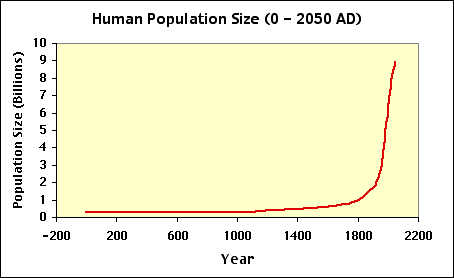Friday, April 22, 2005
A few unsettling stats for Earth Day 2005. If anyone wants specific sources for any of the following, I'll be glad to supply them via e-mail (lowredmail@mac.com).
The world’s human population increases by about 27 people every 10 seconds. In the first century A.D., there were only about 150-200 million human beings living on Earth. In 1800, the human population had grown to about 900 million. By 1900, it had increased to about 1 billion. As of 19:04 GMT (EST+5) April 22, 2005, the world population had reached a staggering 6,432,227,025. By 2020, the human population may "level out" at somewhere between 8 and 15 billion people (the two extremes of this estimate represent the optimistic and pessimistic views, respectively, of future fertility rates in developing countries — the United Nations currently projects 11 billion). "Carrying capacity" is defined as the population of a given species that can be supported indefinitely in a defined habitat without permanently damaging the ecosystem upon which it is dependent. For humans, the Earth’s carrying capacity is estimated by ecologists to be about 2 billion people.

A study by Cornell Unviersity ecologists states that nearly one-third of the world's cropland has been abandoned during the past 40 years because erosion has made it unproductive. Meanwhile, urban sprawl is claiming farmland at a rate of 1.2 million acres a year.
Although extinction is undeniably a natural and ongoing process, current and projected extinction rates are estimated to be 1,000 to 10,000 times the natural background rate. More than 150 bird species, alone, are known to have gone extinct (or are very likely to have done so) in the last 500 years. In the last two millennia, over 2,000 bird species on Polynesian islands may have been driven extinct as a direct or indirect result of human activities. According to World Conservation Union estimates, 25% of all mammals and amphibians are currently at high risk of extinction, with 20% of reptiles and 34% of freshwater fish at comparable risk levels. For example: Of the eight original subspecies of tigers, three have become extinct in the last 60 years, an average of one every 20 years. Only 4,600-7,700 wild tigers remain (that means that there’s slightly less than a million times as many humans as tigers, if we go with the more optimistic estimate of 7,700 tigers). Today, all five species of rhinos are perilously close to extinction. In the 1970s alone, half the world's rhino population disappeared. Today, less than 15% of the population present in 1970 remains, an estimated 10,000 to 11,000 rhinos worldwide. The Earth is presently facing a biotic crisis greater than the extinction event that claimed the non-avian dinosaurs. Habitat loss and degradation due to human activity is currently the primary force driving this extinction. For example: Half of the world’s wetlands have been destroyed. 90% of wetlands along the Mississipii River have vanished.
One pound of beef requires the expenditure of three-quarters of a gallon of oil to produce. The U.S. consumes 7,191 million gallons of oil annually, and this figure is expected to rise by 50% over the next 20 years. The United States consumed 19.7 million barrels of oil per day in 2000, more than half of which (10.4 million barrels per day net) came from imports.
Globally, temperatures are rising. The global average air temperature at the Earth’s surface has risen one degree Fahrenheit in the last century alone. The Intergovernmental Panel on Climate Change estimates that rising C02 emissions, mostly from the burning of fossil fuels, is responsible for about 60% of the warming seen since 1850. Carbon dioxide has been increasing at a rate of .03%/year, and rates are now 30% higher than before the industrial revolution. Methane levels are also rising, and this greenhouse gas is now 2.5 times as prevalent in our atmosphere as it was in the 18th century. The IPCC predicts that over the next century global average temperatures will increase by 1.8 to 6.3 degrees Fahrenheit. This rise results in, among other things, rising sea levels. The IPCC has projected a sea level rise of 4-35 inches by the end of this century. A rise of only 1.5 feet would submerge 75% of coastal Louisiana. Worldwide, tens of millions of people will be displaced as sea levels rise, further stressing environments. Moreover, temperatures are rising faster at the poles than elsewhere on the planet. Since 1979, the extent of sea ice in the Artic has been decreasing by 9%/year. Some scientists predict that sea ice may be absent from the Artic in summer months as early as 2100. In the Antarctic, the Larsen Ice Shelf is collapsing. A total of about 3,250 km2 of shelf area disintegrated in a 35-day period beginning on January 31, 2002. Between 2000-2004, the shelf lost a total of 5,700 km2, and is now about 40 percent the size of its previous minimum stable extent. Woldwide, glaciers are retreating and vanishing.
Now, let's be very imaginative and pretend that these figures are wildly inaccurate. In fact, let's say things are only half this bad. Hell, maybe the Earth's carrying capacity for humans is actually five billion. Still, we've already exceeded that by 1.4 billion people. Even if many scientists in many disciplines are very wrong, even if enviromentalists are exagerrating (for whatever reason), it still adds up to a worldwide disaster that will impact the lives of all human beings, not to mention virtually every other species presently living on Earth.
Four groups trying to make things less wrong:
World Wildlife Foundation
The Nature Conservancy
Greenpeace
World Land Trust


|
|


